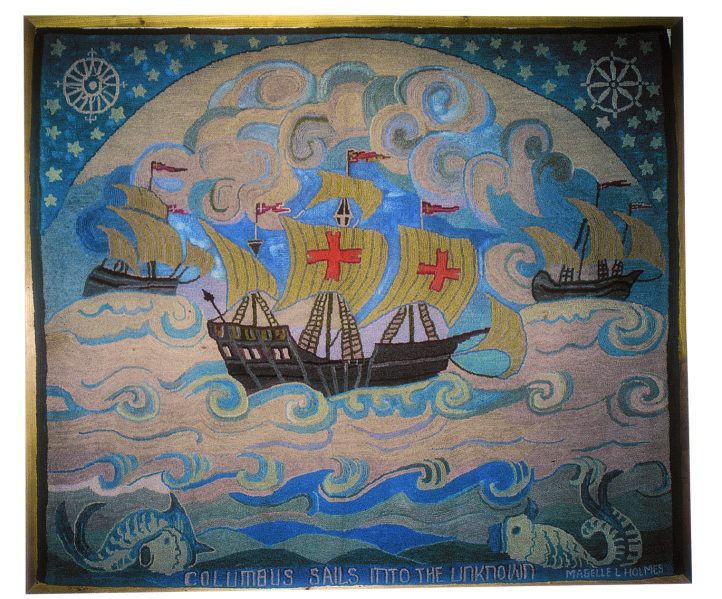
COLUMBUS SAILS INTO THE UNKNOWN, 5′ x 6′, #6-8 cut wool on monk’s cloth. Designed and hooked by Mabelle Linnea Holmes, Waynesboro, Virginia, 1933. In 1492, the daring Genoese navigator set his sails westward from Palos, Spain, his three tiny ships flying the banners of his royal benefactors, Ferdinand of Aragon and Isabella of Castile. PHOTOGRAPHS COURTESY OF THE JAMESTOWN-YORKTOWN FOUNDATION, YORKTOWN, VIRGINIA
On a visit to the Jamestown-Yorktown Foundation in Yorktown, Virginia, I was given a glimpse of part of the collection of the Mabelle Linnea Holmes hooked rugs. When I first saw The Coming of the Norseman, I was struck not only by the pristine condition of a rug that is 75 years old, but also by the primitive design depicting such an historical event. How could one woman hook one of these rugs much less an entire collection of 20 in a lifetime? They are truly beautiful and obviously a labor of love by the artist.
Going Back
During World War I, Mabelle was a member of the Yeomanettes, the forerunners of the WAVES (Women Accepted for Voluntary Emergency Service). During this time, she became caught up in the pageantry of the times and wanted to memorialize America’s heritage. She decided to design rugs pertaining to different events in our history and felt the primitive nature of hooked rugs would reflect the pioneering spirit of the country. So, in 1930 at the age of 36, Mabelle set out to hook a series of 20 rugs depicting the birth of a nation.
The Bayeaux Tapestries from England, which portray the Norman Conquest in 1066, greatly influenced her designs. Even though Mabelle’s rugs were made in the fashion of traditional hooked rugs using strips of wool, they have often been described as tapestries. Her studies at the University of Minnesota and the Herron Art Institute, Indianapolis, Indiana, provided her with an education in art, which she then applied to her rugs. She also studied at the Instituto de Allende in Mexico where she learned how to create murals, which further helped in designing her rugs. It took 40 years to hook all the rugs, and in the beginning, she would complete one a year. However, in later years, it would take her two years to finish a rug.
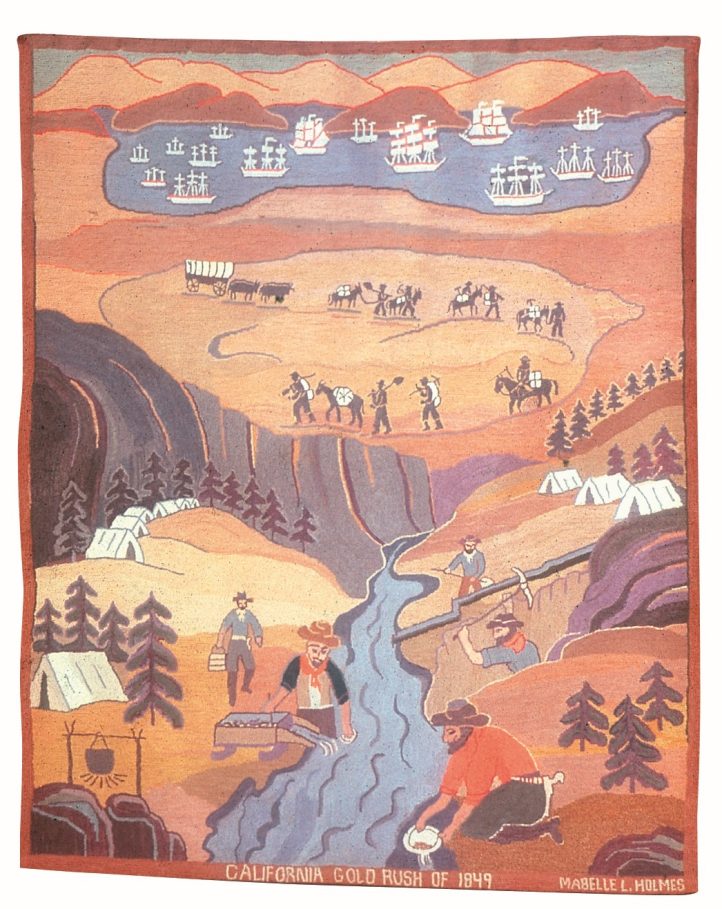
CALIFORNIA GOLD RUSH, 5′ x 6′, #6-8 cut wool on monk’s cloth. Designed and hooked by Mabelle Linnea Holmes, Waynesboro, Virginia. In 1848 James Marshall discovered gold on the South Fork of the American River. Within a few months one of the great international migrations of all time was on when the “forty-niners” poured into California from all parts of the world.
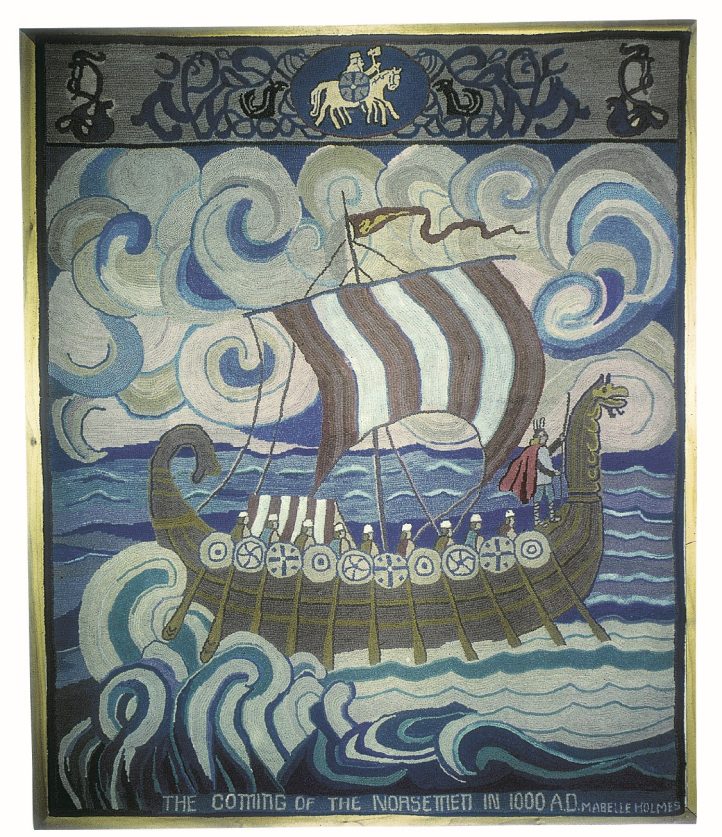
COMING OF THE NORSEMAN IN 1000 A.D., 5′ x 6′, #6-8 cut wool on monk’s cloth. Designed and hooked by Mabelle Linnea Holmes, Waynesboro, Virginia, 1931. Leif Ericson set out to find new lands along the North Atlantic coast, naming the lands he visited Helluland, Markland, and Vinland.
Research
Each rug is an original design based on months of research. Mabelle would visit most of the places where the event occurred to insure the authenticity of her designs.
Hooked in 1931, her first rug, Coming of the Norseman in 1000 A. D. had a special significance for Mabelle. She remembered being told stories by her parents of how they crossed the Atlantic Ocean and came to America as immigrants from Scandinavia. Her research for this rug involved studying the Olde Norse Sagas (the sayings of the elders describing the journeys of the Vikings). From there she went on to hook 19 other rugs depicting major events in the history of America and its westward expansion.
She followed the trail in Kentucky blazed by Daniel Boone for her rug Daniel Boone Guides the Settlers on the Wilder-ness Road. Her rug On the Santa Fe Trail came to life when she actually followed the trail on a trip with her husband. For The California Gold Rush, she visited old gold mines and ghost towns of the West, and even interviewed the son of a real “49er” prospector to formulate her design. They also visited old Spanish Missions in California which inspired Mabelle to design a rug based on one of the Franciscan Brothers’ stories about the founding of one of the Spanish missions in Santa Barbara—Father Junipero Serra Begins the San Diego Mission. She studied the history of America in depth by reading old diaries, journals, logbooks, and letters written by early explorers and missionaries, especially the Franciscans and Jesuits.
Reading the logbook written by Columbus while on his voyage to the New World inspired Columbus Sails into the Un-known, her second rug which was hooked in 1933. She continued to tell the story of America’s early years with Columbus Takes Possession of the New World and Ponce De Leon Discovers America-1513. Hooked in 1955, Lewis and Clark’s Expedition on the Oregon Trail depicts our history from 1804-1860. The expedition commissioned by Thomas Jefferson, led a bank of soldiers and civilians in search of a practical land-water route from St. Louis to the Pacific. Mabelle then went on to design rugs based on the landing of the pilgrims at Plymouth, Massachusetts; William Penn bartering with the Indians; Marquette and Joliet exploring the Mississippi; and George Washington at Valley Forge.
It took three visits to Jamestown, Virginia to finalize Mabelle’s design for Pocahontas and the Jamestown Colony. During her visits, preparation was in process for our country’s 350th celebration of the founding of the Jamestown Colony. Replicas of the Indian village where Pocahontas lived, Fort James, and the three ships which brought colonists to the Jamestown, were being constructed. The rug depicts the first permanent English settlement in America and was her sixth rug. It was hooked in 1957, over 25 years since beginning the series.

POCOHANTAS AND THE JAMESTOWN COLONY, 5′ x 6′, #6-8 cut wool on monk’s cloth. Designed and hooked by Mabelle Linnea Holmes, Waynesboro, Virginia, 1957. Founded on Algonquian Indian land in 1607, Jamestown, Virginia was the first permanent English settlement in America.
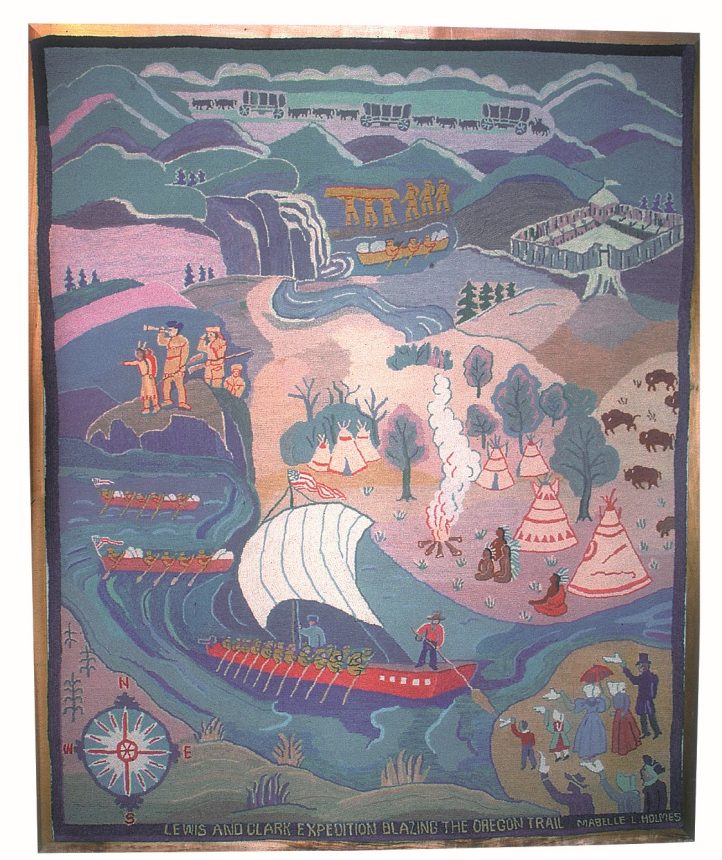
LEWIS AND CLARK ON THE OREGON TRAIL, 5′ x 6′, #6-8 cut wool on monk’s cloth. Designed and hooked by Mabelle Linnea Holmes, Waynesboro, Virginia, 1955. In 1804-1806 Lewis and Clark led a band of some 40 soldiers and civilians through vast, uncharted territory to find a practical land-water route from St. Louis to the Pacific.
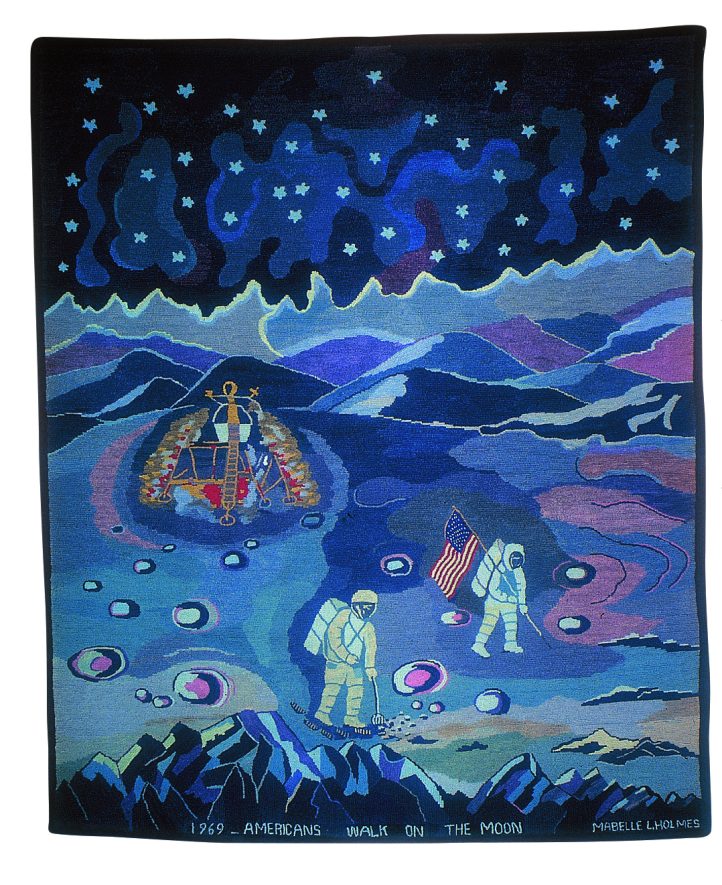
AMERICANS WALK ON THE MOON, 5′ x 6′, #6-8 cut wool on monk’s cloth. Designed and hooked by Mabelle Linnea Holmes, Waynesboro, Virginia, 1970. In 1969 Neil Armstrong, commander of the Apollo XI mission stepped on the moon, followed by Edwin (Buzz) Aldrin. Among the things they left behind was a plaque that read “Here men from plan-et Earth first set foot upon the moon. We came in peace for all mankind.”
Mabelle’s Techniques
After extensive research for each rug, Mabelle first drew an 18″ x 24″ pencil sketch, a watercolor or acrylic painting of her idea before transferring it to monk’s cloth. Only then did she undertake the task of hooking the 5′ x 6′ rug with strips of wool fabric. While it is not known exactly what cuts of wool Mabelle used, they have been described as being “the width of shoelaces.” Upon inspection, they are clearly hooked in a wider cut strip, most likely a #6 through #8 cut.
The wool was hand dyed using mostly natural dyes. Some formulas for dyes were obtained from old New England cookbooks dating back to 1750 as well as more recent books on vegetable and naturally dyeing. In order to achieve the colors needed, she experimented with dyes made from plants, flowers, seeds, barks, and nuts which she gathered from nature and even her own back yard. She would often obtain these while on vacation and bring them home to use in her dye formulas. Searching for just the right natural dye materials gave a special purpose and added interest to her vacations which she and her husband took to places like the Blue Ridge and Smokey Mountains as well as New England and the Midwest. Mabelle once stated that her kitchen “became a dye-making laboratory.” The colors of the rugs today have faded only slightly since the wool was dyed with natural dyes, but they remain a spectacular account of American history.
The last rug hooked by Mabelle for this series was Americans Walk on the Moon based on the 1969 moon walk of Neil Arm-strong. It was hooked in 1970 when she was 75 years old. Eleven years later Mabelle donated the rugs along with the paintings, pencil sketches, her hook, and handmade rug hooking frame to the Jamestown-York-town Foundation in Yorktown Virginia. She died in 1987 at the age of 92.
The rugs have been exhibited at various times throughout the United States, including the International Exposition of Arts and Industries at Madison Square Garden along with museums, colleges, art exhibitions, and the Jamestown-Yorktown Foundation. Her work has been described as “combining the freedom and imagination of children’s art with the structural clarity of folk art.” This collection of American history in hooked rugs was last exhibited in the early 1990s. However, it is hoped that they will be shown again some time in the near future.
Mary would like to acknowledge Jane Mackley, Registrar, and Bobby Hair-Granger, Museum Technician of the Jamestown-Yorktown Foundation for their time and assistance to provide research for this article.
